Electrodeposition of Ti-Doped Hierarchically Mesoporous Silica Microspheres/Tungsten Oxide Nanocrystallines Hybrid Films and Their Electrochromic Performance
Abstract
1. Introduction
2. Experimental Sections
2.1. Materials
2.2. Fabrication of Porous THMS/WO3 Hybrid Films
2.3. Electrochemical Characterization
2.4. Sample Characterization
3. Results and Discussion
3.1. Synthesis of Ti-Doped Hierarchically Mesoporous Silica Microspheres (THMSs)
3.2. Fabrication of THMS/WO3 Hybrid Films
3.3. Electrochromic Properties of THMS/WO3 Hybrid Films
3.3.1. Electrochemical Performances
3.3.2. Optical Performances
4. Conclusions
Supplementary Materials
Author Contributions
Funding
Acknowledgments
Conflicts of Interest
References
- Granqvist, C.G.; Arvizu, M.A.; Bayrak Pehlivan, İ.; Qu, H.Y.; Wen, R.T.; Niklasson, G.A. Electrochromic materials and devices for energy efficiency and human comfort in buildings: A critical review. Electrochim. Acta 2018, 259, 1170–1182. [Google Scholar] [CrossRef]
- Eh, A.L.-S.; Lin, M.-F.; Cui, M.; Cai, G.; Lee, P.S. A copper-based reversible electrochemical mirror device with switchability between transparent, blue, and mirror states. J. Mater. Chem. C 2017, 5, 6547–6554. [Google Scholar] [CrossRef]
- Lin, L.; Cheng, C.-P.; Teng, T.-P. Electrodeposition-Based fabrication and characteristics of tungsten trioxide thin film. J. Nanomater. 2016, 2016, 1–12. [Google Scholar] [CrossRef]
- Shen, L.; Du, L.; Tan, S.; Zang, Z.; Zhao, C.; Mai, W. Flexible electrochromic supercapacitor hybrid electrodes based on tungsten oxide films and silver nanowires. Chem. Commun. 2016, 52, 6296–6299. [Google Scholar] [CrossRef]
- Dulgerbaki, C.; Oksuz, A.U. Fabricating polypyrrole/tungsten oxide hybrid based electrochromic devices using different ionic liquids. Polym. Adv. Technol. 2016, 27, 73–81. [Google Scholar] [CrossRef]
- Xie, S.; Gong, G.; Song, Y.; Tan, H.; Zhang, C.; Li, N.; Zhang, Y.; Xu, L.; Xu, J.; Zheng, J. Design of novel lanthanide-doped core-shell nanocrystals with dual up-conversion and down-conversion luminescence for anti-counterfeiting printing. Dalton Trans. 2019, 48, 6971–6983. [Google Scholar] [CrossRef]
- Malik, N.; Elool Dov, N.; de Ruiter, G.; Lahav, M.; van der Boom, M.E. On-Surface self-assembly of stimuli-responsive metallo-organic films: Automated ultrasonic spray-coating and electrochromic devices. ACS Appl. Mater. Interfaces 2019, 11, 22858–22868. [Google Scholar] [CrossRef]
- Fang, H.; Zheng, P.; Ma, R.; Xu, C.; Yang, G.; Wang, Q.; Wang, H. Multifunctional hydrogel enables extremely simplified electrochromic devices for smart windows and ionic writing boards. Mater. Horiz. 2018, 5, 1000–1007. [Google Scholar] [CrossRef]
- Kim, H.N.; Yang, S. Responsive smart windows from nanoparticle–polymer composites. Adv. Funct. Mater. 2019, 1902597. [Google Scholar] [CrossRef]
- Cai, G.; Cui, M.; Kumar, V.; Darmawan, P.; Wang, J.; Wang, X. Ultra-large optical modulation of electrochromic porous WO3 film and the local monitoring of redox activity. Chem. Sci. 2016, 7, 1373–1382. [Google Scholar] [CrossRef]
- Shi, Y.; Liu, S.; Zhang, Y.; Sun, M.; Tang, K.; Cui, J.; Shu, X.; Wang, Y.; Liu, J.; Wu, Y. Construction of WO3/Ti-doped WO3 bi-layer nanopore arrays with superior electrochromic and capacitive performances. Tungsten 2019, 1, 236–244. [Google Scholar] [CrossRef]
- Yang, Y.; Du, X.; An, X.; Ding, S.; Liu, F.; Zhang, Z. Potential-induced reversible uptake/release of perchlorate from wastewater by polypyrrole@CoNi-layered double hydroxide modified electrode with proton-ligand effect. J. Colloid Interface Sci. 2018, 523, 159–168. [Google Scholar] [CrossRef] [PubMed]
- Xiong, S.; Jia, P.; Mya, K.Y.; Ma, J.; Boey, F.; Lu, X. Star-like polyaniline prepared from octa (aminophenyl) silsesquioxane: Enhanced electrochromic contrast and electrochemical stability. Electrochim. Acta. 2008, 53, 3523–3530. [Google Scholar] [CrossRef]
- Xu, J.; Feng, Y.; Wu, Y.; Li, Y.; Ouyang, M.; Zhang, X.; Wang, Y.; Wang, Y.; Xu, L. Noninvasive monitoring of bone regeneration using NaYF4: Yb3+, Er3+ upconversion hollow microtubes supporting PLGA-PEG-PLGA hydrogel. React. Funct. Polym. 2019, 143, 104333. [Google Scholar] [CrossRef]
- Havinga, E.; Van Pelt, P. Intramolecular charge transfer, studied by electrochromism of organic molecules in polymer matrices. Mol. Cryst. Liq. Cryst. 1979, 52, 145–155. [Google Scholar] [CrossRef]
- Zhang, Y.-M.; Wang, X.; Zhang, W.; Li, W.; Fang, X.; Yang, B. A single-molecule multicolor electrochromic device generated through medium engineering. Light-Sci. Appl. 2015, 4, e249. [Google Scholar] [CrossRef]
- Zhao, L.; Su, G.; Liu, W.; Cao, L.; Wang, J.; Dong, Z. Optical and electrochemical properties of Cu-doped NiO films prepared by electrochemical deposition. Appl. Surf. Sci. 2011, 257, 3974–3979. [Google Scholar] [CrossRef]
- Liu, Y.; Jia, C.; Wan, Z.; Weng, X.; Xie, J.; Deng, L. Electrochemical and electrochromic properties of novel nanoporous NiO/V2O5 hybrid film. Sol. Energy Mater. Sol. Cells 2015, 132, 467–475. [Google Scholar] [CrossRef]
- Yuan, G.; Hua, C.; Khan, S.; Jiang, S.; Wu, Z.; Liu, Y. Improved electrochromic performance of WO3 films with size controlled nanorods. Electrochim. Acta 2018, 260, 274–280. [Google Scholar] [CrossRef]
- Atak, G.; Coşkun, Ö.D. Fabrication of an all solid-state electrochromic device using zirconium dioxide as an ion-conducting layer. Thin Solid Films 2018, 664, 70–78. [Google Scholar] [CrossRef]
- Costa, C.; Pinheiro, C.; Henriques, I.; Laia, C.A. Inkjet printing of sol-gel synthesized hydrated tungsten oxide nanoparticles for flexible electrochromic devices. ACS Appl. Mater. Interfaces 2012, 4, 1330–1340. [Google Scholar] [CrossRef] [PubMed]
- Wang, Y.; Meng, Z.; Chen, H.; Li, T.; Zheng, D.; Xu, Q. Pulsed electrochemical deposition of porous WO3 on silver networks for highly flexible electrochromic devices. J. Mater. Chem. C 2019, 7, 1966–1973. [Google Scholar] [CrossRef]
- Baloukas, B.; Lamarre, J.M.; Martinu, L. Electrochromic interference filters fabricated from dense and porous tungsten oxide films. Sol. Energy Mater. Sol. Cells 2011, 95, 807–815. [Google Scholar] [CrossRef]
- Tuna, Ö.; Sezgin, A.; Budakoğlu, R.; Türküz, S.; Parlar, H. Electrochromic properties of tungsten trioxide (WO3) layers grown on ITO/glass substrates by magnetron sputtering. Vacuum 2015, 120, 28–31. [Google Scholar] [CrossRef]
- Zhou, K. The Mechanism of Trapped Ions Eroding the Electrochromic Performances of WO3 Thin Films. Int. J. Electrochem. Sci. 2018, 13, 7335–7346. [Google Scholar] [CrossRef]
- Wu, C.-L.; Lin, C.-K.; Wang, C.-K.; Wang, S.-C.; Huang, J.-L. Annealing induced structural evolution and electrochromic properties of nanostructured tungsten oxide films. Thin Solid Films 2013, 549, 258–262. [Google Scholar] [CrossRef]
- More, A.J.; Patil, R.S.; Dalavi, D.S.; Mali, S.S.; Hong, C.K.; Gang, M.G.; Kim, J.H.; Patil, P.S. Electrodeposition of nano-granular tungsten oxide thin films for smart window application. Mater. Lett. 2014, 134, 298–301. [Google Scholar] [CrossRef]
- Han, J.; Ko, K.-W.; Sarwar, S.; Lee, M.-S.; Park, S.; Hong, S.; Han, C.-H. Enhanced electrochromic properties of TiO2 nanocrystal embedded amorphous WO3 films. Electrochim. Acta 2018, 278, 396–404. [Google Scholar] [CrossRef]
- Li, N.; Wei, P.; Yu, L.; Ji, J.; Zhao, J.; Gao, C. Dynamically switchable multicolor electrochromic films. Small 2019, 15, e1804974. [Google Scholar] [CrossRef]
- Dalavi, D.S.; Devan, R.S.; Patil, R.A.; Patil, R.S.; Ma, Y.-R.; Sadale, S.B. Efficient electrochromic performance of nanoparticulate WO3 thin films. J. Mater. Chem. C 2013, 1, 3722–3728. [Google Scholar] [CrossRef]
- Xie, Z.; Zhang, Q.; Liu, Q.; Zhai, J.; Diao, X. Enhanced electrochromic performance of 2D grid-structured WO3 thin films. Thin Solid Films 2018, 653, 188–193. [Google Scholar] [CrossRef]
- Zhang, J.; Tu, J.P.; Cai, G.F.; Du, G.H.; Wang, X.L.; Liu, P.C. Enhanced electrochromic performance of highly ordered, macroporous WO3 arrays electrodeposited using polystyrene colloidal crystals as template. Electrochim. Acta 2013, 99, 1–8. [Google Scholar] [CrossRef]
- Yan, L.; Yu, J.; Zhong, Y.; Gu, Y.; Ma, Y.; Li, W. Influence of scanning on nano crystalline β-Ti alloys fabricated by selective laser melting and their applications in biomedical science. J. Nanosci. Nanotechnol. 2020, 20, 1605–1612. [Google Scholar] [CrossRef] [PubMed]
- Zhou, H.; Zhou, J.; Wang, T.; Zeng, J.; Liu, L.; Jian, J. In-situ preparation of silver salts/collagen fiber hybrid composites and their photocatalytic and antibacterial activities. J. Hazard. Mater. 2018, 359, 274–280. [Google Scholar] [CrossRef]
- Ling, H.; Lu, J.; Phua, S.; Liu, H.; Liu, L.; Huang, Y. One-pot sequential electrochemical deposition of multilayer poly(3,4-ethylenedioxythiophene): Poly(4-styrenesulfonic acid)/tungsten trioxide hybrid films and their enhanced electrochromic properties. J. Mater. Chem. A 2014, 2, 2708–2717. [Google Scholar] [CrossRef]
- Song, X.C.; Zheng, Y.F.; Ma, R.; Yin, H.Y. Electrodeposition of poly(3-chlorothiophene) film on WO3 surfaces in an ionic liquid. J. Macromol. Sci. B 2012, 51, 1080–1088. [Google Scholar] [CrossRef]
- Fu, C.; Foo, C.; Lee, P.S. One-step facile electrochemical preparation of WO3/graphene nanocomposites with improved electrochromic properties. Electrochim. Acta 2014, 117, 139–144. [Google Scholar] [CrossRef]
- Cai, G.F.; Zhou, D.; Xiong, Q.Q.; Zhang, J.H.; Wang, X.L.; Gu, C.D. Efficient electrochromic materials based on TiO2@WO3 core/shell nanorod arrays. Sol. Energy Mater. Sol. Cells 2013, 117, 231–238. [Google Scholar] [CrossRef]
- Acosta, D.R.; Magaña, C.; Hernández, F.; Ortega, J. Electrical, optical and electrochromic properties of Ti: WO3 thin films deposited by the pulsed chemical spray technique. Thin Solid Films 2015, 594, 207–214. [Google Scholar] [CrossRef]
- Karuppasamy, A. Electrochromism and photocatalysis in dendrite structured Ti: WO3 thin films grown by sputtering. Appl. Surf. Sci. 2015, 359, 841–846. [Google Scholar] [CrossRef]
- Barawi, M.; Veramonti, G.; Epifani, M.; Giannuzzi, R.; Sibillano, T.; Giannini, C.; Manca, M. A dual band electrochromic device switchable across four distinct optical modes. J. Mater. Chem. A 2018, 6, 10201–10205. [Google Scholar] [CrossRef]
- Cai, G.-F.; Wang, X.-L.; Zhou, D.; Zhang, J.-H.; Xiong, Q.-Q.; Gu, C.-D. Hierarchical structure Ti-doped WO3 film with improved electrochromism in visible-infrared region. RSC Adv. 2013, 3, 6896–6905. [Google Scholar] [CrossRef]
- Du, G.; Song, Y.; Li, N.; Xu, L.; Tong, C.; Feng, Y.; Chen, T.; Xu, J. Cage-like hierarchically mesoporous hollow silica microspheres templated by mesomorphous polyelectrolyte-surfactant complexes for noble metal nanoparticles immobilization. Colloid. Surface. A 2019, 575, 129–139. [Google Scholar] [CrossRef]
- Shi, C.; Wang, W.; Liu, N.; Xu, X.; Wang, D.; Zhang, M. Low temperature oxidative desulfurization with hierarchically mesoporous titaniumsilicate Ti-SBA-2 single crystals. Chem. Commun. 2015, 51, 11500–11503. [Google Scholar] [CrossRef]
- Tan, H.; Gong, G.; Xie, S.; Song, Y.; Zhang, C.; Li, N.; Zhang, D.; Xu, L.; Xu, J.; Zheng, J. Upconversion nanoparticles@carbon dots@meso-SiO2 sandwiched core-shell nanohybrids with tunable dual-mode luminescence for 3D anti-counterfeiting barcodes. Langmuir 2019, 35, 11503–11511. [Google Scholar] [CrossRef]
- Li, Y.; McMaster, W.A.; Wei, H.; Chen, D.; Caruso, R.A. Enhanced electrochromic properties of WO3 nanotree-like structures synthesized via a two-step solvothermal process showing promise for electrochromic window application. ACS Appl. Nano Mater. 2018, 1, 2552–2558. [Google Scholar] [CrossRef]
- Gong, G.; Song, Y.; Tan, H.; Xie, S.; Zhang, C.; Xu, L.; Xu, J.; Zheng, J. Design of core/active-shell NaYF4: Ln3+@NaYF4: Yb3+ nanophosphors with enhanced red-green-blue upconversion luminescence for anti-counterfeiting printing. Compos. Part B-Eng. 2019, 179, 107504. [Google Scholar] [CrossRef]
- Zhan, Y.; Tan, M.R.J.; Cheng, X.; Tan, W.M.A.; Cai, G.F.; Chen, J.W. Ti-Doped WO3 synthesized by a facile wet bath method for improved electrochromism. J. Mater. Chem. C 2017, 5, 9995–10000. [Google Scholar] [CrossRef]
- Das, A.K.; Paria, S.; Maitra, A.; Halder, L.; Bera, A.; Bera, R. Highly rate capable nanoflower-like NiSe and WO3@PPy composite electrode materials toward high energy density flexible all-solid-state asymmetric supercapacitor. ACS Appl. Electron. Mater. 2019, 1, 977–990. [Google Scholar] [CrossRef]
- Zhang, W.; Wang, X.; Wang, Y.; Yang, G.; Gu, C.; Zheng, W. Bio-inspired ultra-high energy efficiency bistable electronic billboard and reader. Nat. Commun. 2019, 10, 1559. [Google Scholar] [CrossRef]
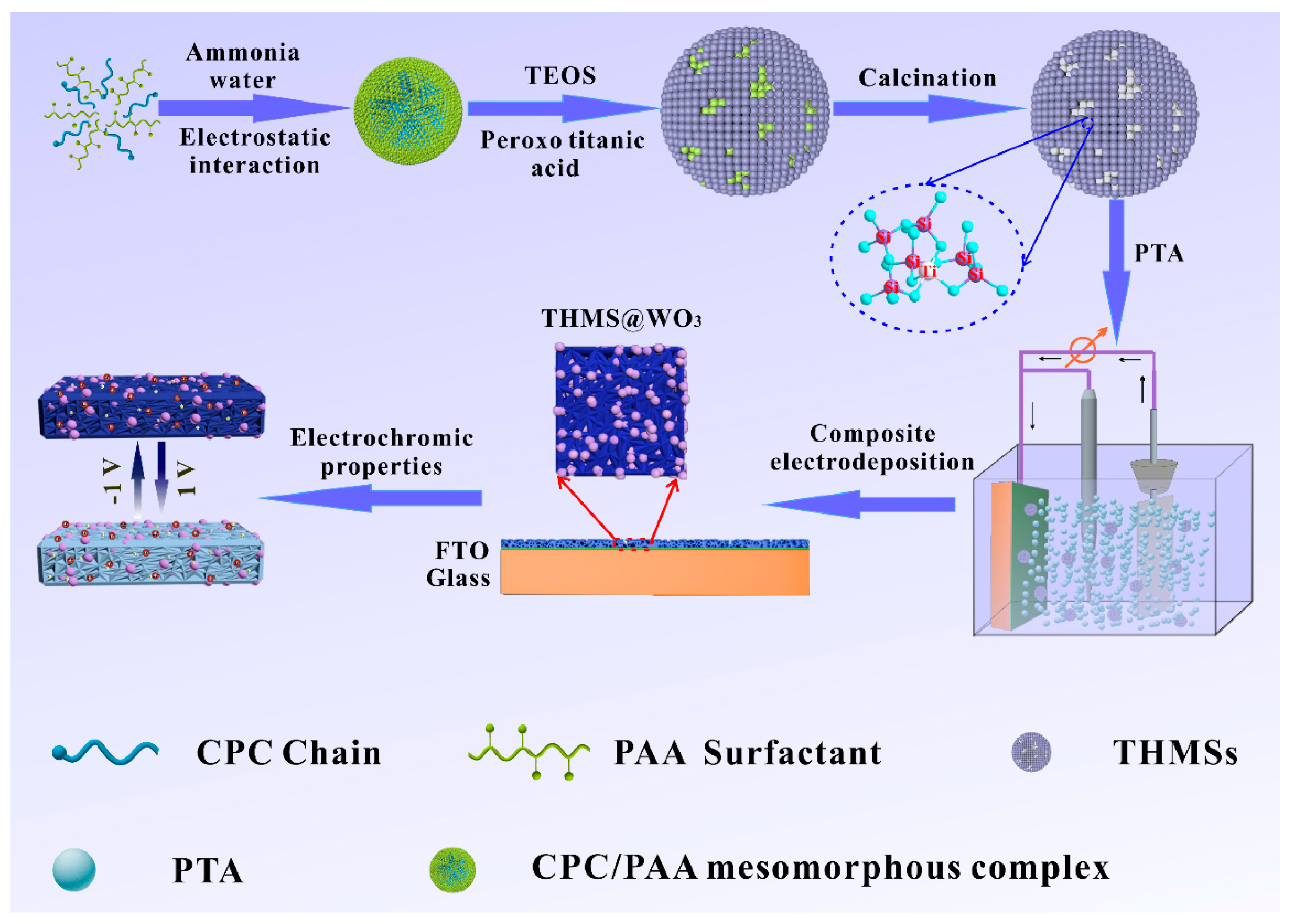
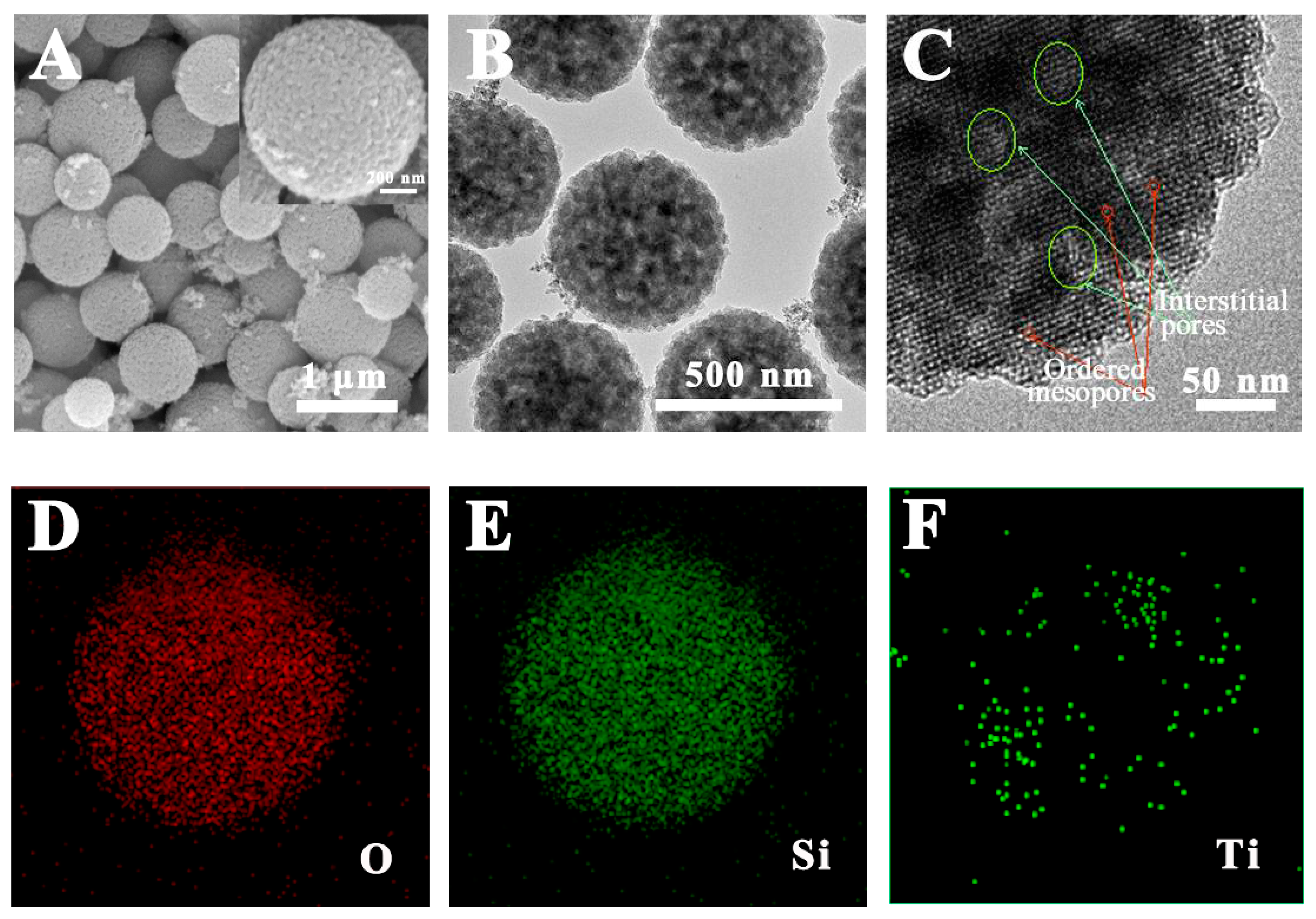

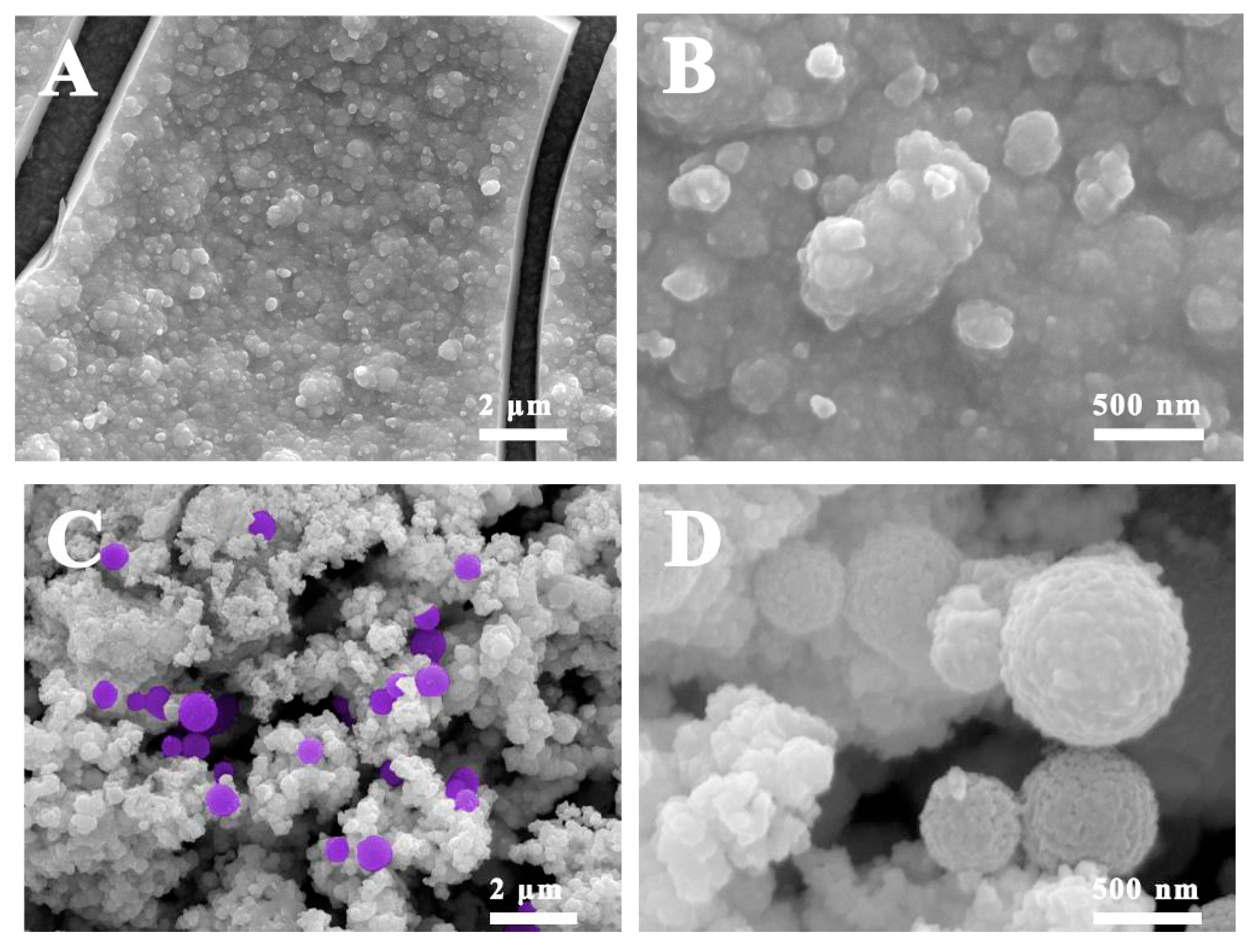
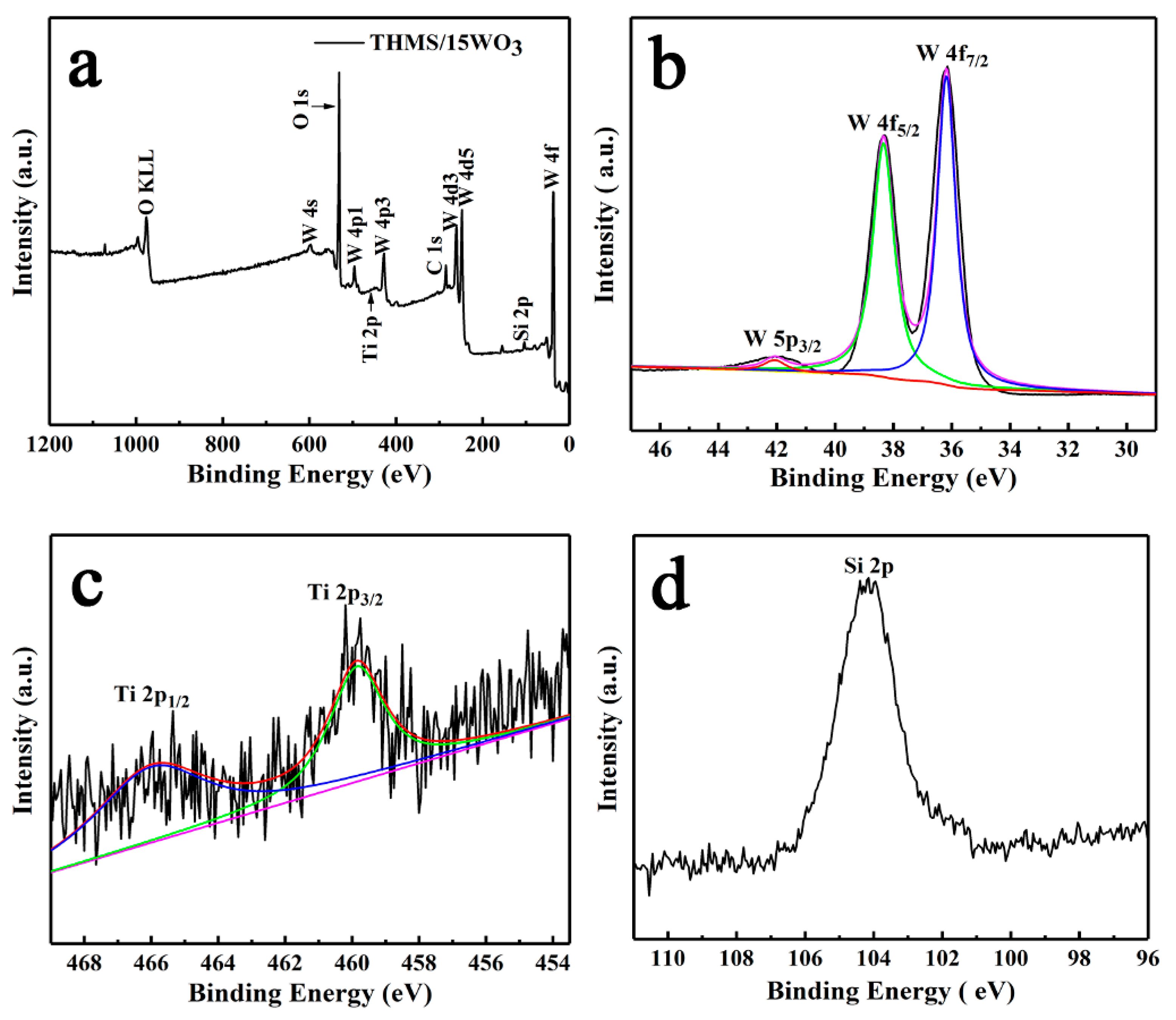
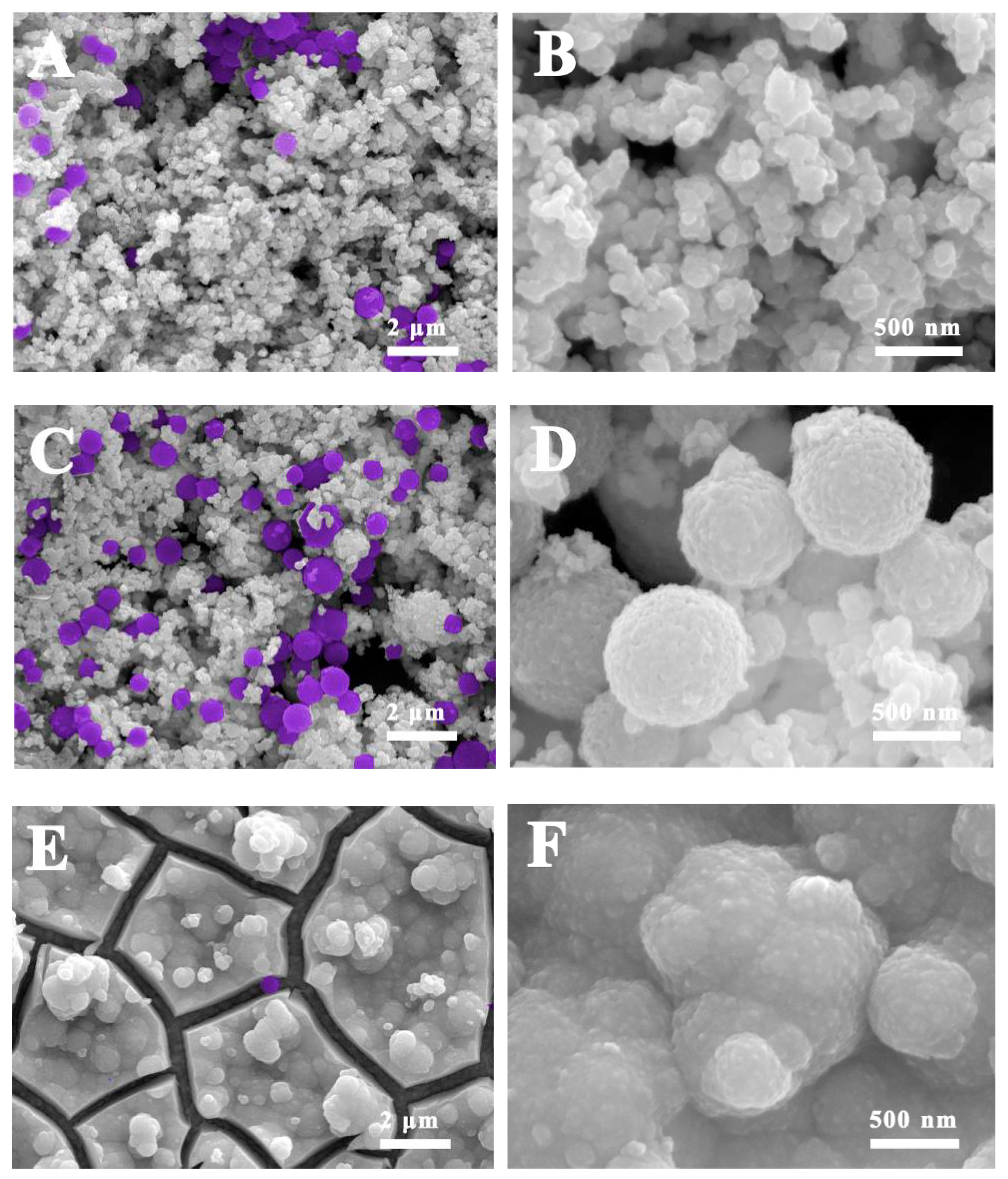
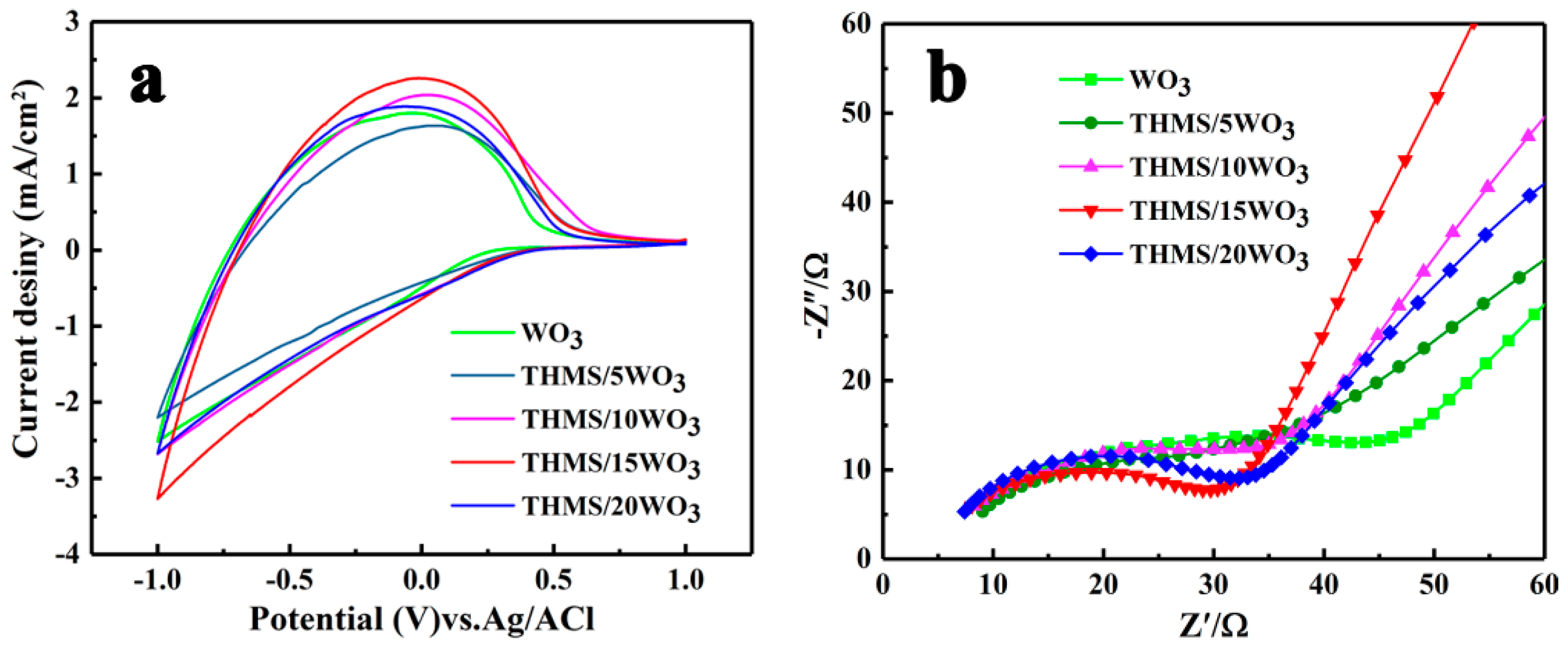

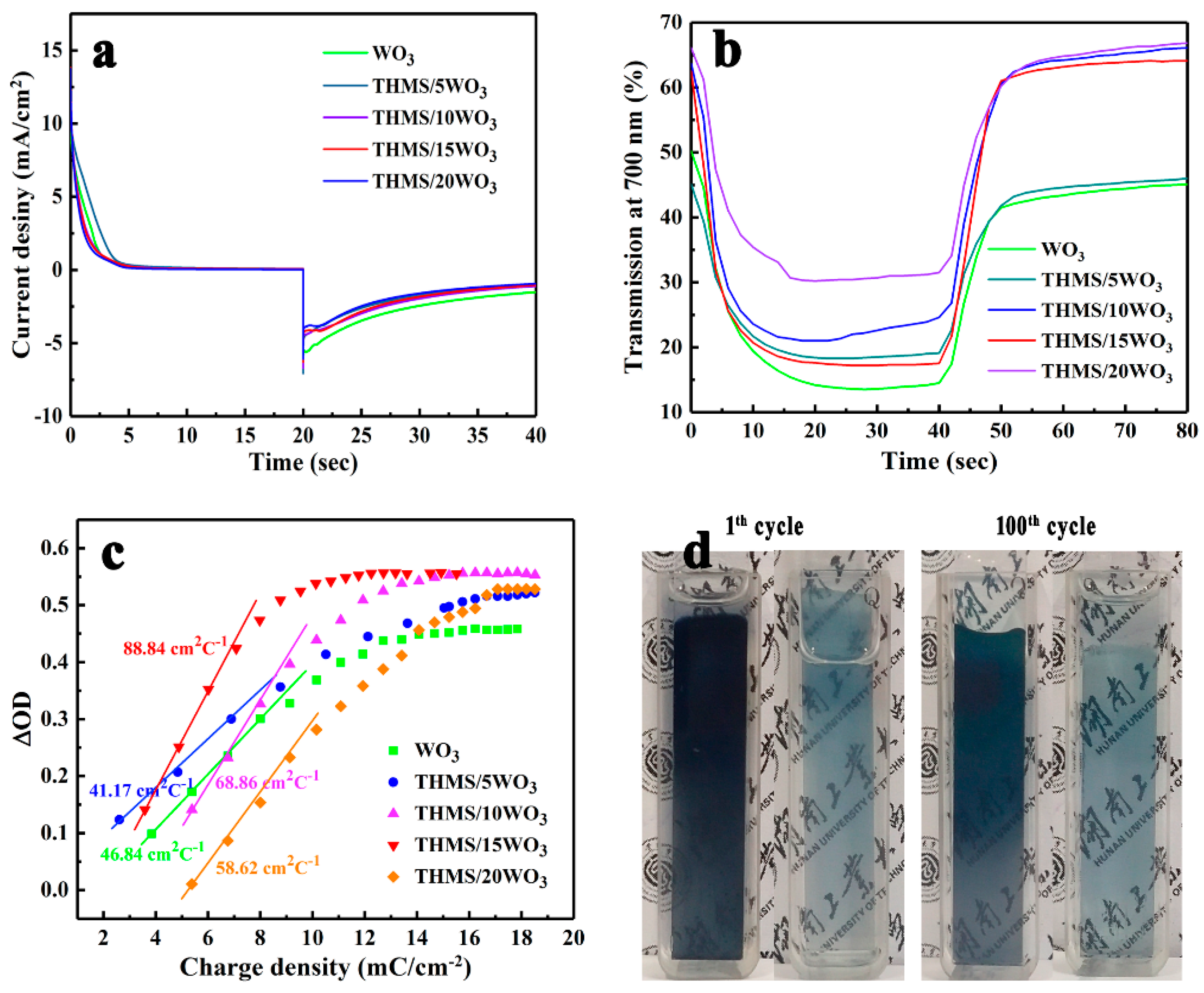
| Sample | Diffusion Coefficient (cm2 s−1) | Switching Time | Coloration Efficiency (cm2 C−1) λ = 700 nm | Modulation Rang of the Transmittance (%) λ = 700 nm | |
|---|---|---|---|---|---|
| tc (s) | tb (s) | ||||
| WO3 | 8.82 × 10−7 | 19.15 | 14.23 | 46.84 | 34.10 |
| THMS/5WO3 | 7.85 × 10−7 | 15.68 | 12.27 | 41.17 | 32.49 |
| THMS/10WO3 | 9.67 × 10−7 | 13.86 | 14.19 | 68.86 | 48.77 |
| THMS/15WO3 | 1.16 × 10−6 | 14.50 | 11.83 | 88.84 | 52.00 |
| THMS/20WO3 | 6.09 × 10−7 | 14.06 | 14.22 | 58.62 | 37.77 |
© 2019 by the authors. Licensee MDPI, Basel, Switzerland. This article is an open access article distributed under the terms and conditions of the Creative Commons Attribution (CC BY) license (http://creativecommons.org/licenses/by/4.0/).
Share and Cite
Song, Y.; Zhang, Z.; Yan, L.; Zhang, L.; Liu, S.; Xie, S.; Xu, L.; Du, J. Electrodeposition of Ti-Doped Hierarchically Mesoporous Silica Microspheres/Tungsten Oxide Nanocrystallines Hybrid Films and Their Electrochromic Performance. Nanomaterials 2019, 9, 1795. https://doi.org/10.3390/nano9121795
Song Y, Zhang Z, Yan L, Zhang L, Liu S, Xie S, Xu L, Du J. Electrodeposition of Ti-Doped Hierarchically Mesoporous Silica Microspheres/Tungsten Oxide Nanocrystallines Hybrid Films and Their Electrochromic Performance. Nanomaterials. 2019; 9(12):1795. https://doi.org/10.3390/nano9121795
Chicago/Turabian StyleSong, Ya, Zhiyu Zhang, Lamei Yan, Ling Zhang, Simin Liu, Shaowen Xie, Lijian Xu, and Jingjing Du. 2019. "Electrodeposition of Ti-Doped Hierarchically Mesoporous Silica Microspheres/Tungsten Oxide Nanocrystallines Hybrid Films and Their Electrochromic Performance" Nanomaterials 9, no. 12: 1795. https://doi.org/10.3390/nano9121795
APA StyleSong, Y., Zhang, Z., Yan, L., Zhang, L., Liu, S., Xie, S., Xu, L., & Du, J. (2019). Electrodeposition of Ti-Doped Hierarchically Mesoporous Silica Microspheres/Tungsten Oxide Nanocrystallines Hybrid Films and Their Electrochromic Performance. Nanomaterials, 9(12), 1795. https://doi.org/10.3390/nano9121795




